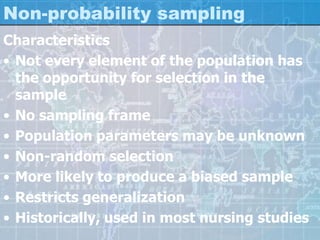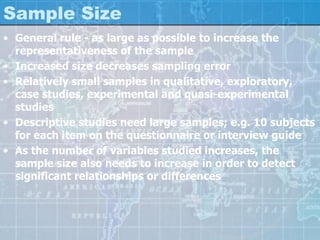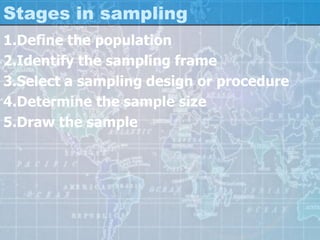Sampling methods
- 1. Sampling Methods Sarika Sawant, PhD SHPT School of Library Science SNDT WU MUMBAI Pre-PhD Course-1 Research Methodology in Education July 5, 2014 College of Education and Research
- 2. Concept of universe / population Depend on research question geographical terms (locality, municipality, district, province, country or some intermediate category) or in sectoral terms (urban population, pottery manufacturers, farmers) • For example, research about voting in an upcoming election would have a universe comprising all voters. If the research was about political parties' sponsorship of candidates, the research would include all political parties.
- 3. Sampling • A sample is “a smaller (but hopefully representative) collection of units from a population used to determine truths about that population” (Field, 2005) • Why need sampling? • Resources (time, money) and workload • Gives results with known accuracy that can be calculated mathematically Population Sample Population Sample Population Sample
- 4. Population • Definition - a complete set of elements (persons or objects) that possess some common characteristic defined by the sampling criteria established by the researcher • Composed of two groups - • target population & • accessible population
- 5. Target population (universe) • The entire group of people or objects to which the researcher wishes to generalize the study findings • Meet set of criteria of interest to researcher • Examples • All institutionalized elderly with Alzheimer's • All people with AIDS • All low birth weight infants • All school-age children with asthma • All pregnant teens
- 6. Accessible population • the portion of the population to which the researcher has reasonable access; may be a subset of the target population • May be limited to region, state, city, county, or institution • Examples • All institutionalized elderly with Alzheimer's in St. Louis county nursing homes • All people with AIDS in the metropolitan St. Louis area • All low birth weight infants admitted to the neonatal ICUs in St. Louis city & county • All school-age children with asthma treated in pediatric asthma clinics in university-affiliated medical centers in the Midwest • All pregnant teens in the state of Missouri
- 7. Sample/Sampling • Sample = the selected elements (people or objects) chosen for participation in a study; people are referred to as subjects or participants • Sampling = the process of selecting a group of people, events, behaviors, or other elements with which to conduct a study • Sampling frame = a list of all the elements in the population from which the sample is drawn
- 8. Contd • Sample could be extremely large if population is national or international in nature • Frame is needed so that everyone in the population is identified so they will have an equal opportunity for selection as a subject (element)
- 9. Examples • A list of all institutionalized elderly with Alzheimer's in St. Louis county nursing homes affiliated with BJC • A list of all people with AIDS in the metropolitan St. Louis area who are members of the St. Louis Effort for AIDS • A list of all low birth weight infants admitted to the neonatal ICUs in St. Louis city & county in 1998 • A list of all school-age children with asthma treated in pediatric asthma clinics in university-affiliated medical centers in the Midwest • A list of all pregnant teens in the Henderson school district
- 10. Imp concepts/ characterstics • Randomization = each individual in the population has an equal opportunity to be selected for the sample • Representativeness = sample must be as much like the population in as many ways as possible • Sample reflects the characteristics of the population, so those sample findings can be generalized to the population • Most effective way to achieve representativeness is through randomization; random selection or random assignment • Accessible and low cost
- 11. Types of Sampling Techniques Probability: A probability sample is one in which each element of the population has a known non-zero probability of selection. • Increases sample's representativeness of the population • Decreases sampling error and sampling bias • Non-probability
- 12. Types of Probability Sample • Simple random sampling • Stratified sampling • Cluster sampling • Systematic sampling
- 13. Simple Random Sampling • A simple random sample (SRS) of size n is produced by a scheme which ensures that each subgroup of the population of size n has an equal probability of being chosen as the sample.
- 14. Stratified Random Sampling • Divide the population into "strata". There can be any number of these. Then choose a simple random sample from each stratum. Combine those into the overall sample. That is a stratified random sample. • Example: Church A has 600 women and 400 men as members. One way to get a stratified random sample of size 30 is to take a SRS of 18 women from the 600 women and another SRS of 12 men from the 400 men.)
- 15. Example
- 16. Types of stratified sampling • Proportional • Disproportional • In proportional stratified, the sample proportions are made to be the same as the population proportions on the stratification variable(s). • In disproportional stratified sampling, the sample proportions are made to be different from the proportions on the stratification variable(s).
- 17. Systematic Random sampling • A random sampling process in which every kth (e.g. every 5th element) or member of the population is selected for the sample after a random start is determined • Example • Population (N) = 2000, sample size (n) = 50, k=N/n, so k = 2000 ) 50 = 40 • Use a table of random numbers to determine the starting point for selecting every 40th subject • With list of the 2000 subjects in the sampling frame, go to the starting point, and select every 40th name on the list until the sample size is reached. Probably will have to return to the beginning of the list to complete the selection of the sample.
- 18. Example
- 19. Cluster random sampling • A random sampling process that involves stages of sampling • The population is first listed by clusters or categories • Procedure • Randomly select 1 or more clusters and take all of their elements (single stage cluster sampling); e.g. Midwest region of the US • Or, in a second stage randomly select clusters from the first stage of clusters; eg 3 states within the Midwest region • In a third stage, randomly select elements from the second stage of clusters; e.g. 30 county health dept. nursing administrators from each state
- 20. Example 1 2 4 3
- 21. Difference Stratification Clustering Divide population into groups different from each other: sexes, races, ages Divide population into comparable groups: schools, cities Sample randomly from each group Randomly sample some of the groups Less error compared to simple random More error compared to simple random More expensive to obtain stratification information before sampling Reduces costs to sample only some areas or organizations
- 22. When to use S and C sampling When to use stratified sampling • If primary research objective is to compare groups • Using stratified sampling may reduce sampling errors When to use cluster sampling • If there are substantial fixed costs associated with each data collection location • When there is a list of clusters but not of individual population members
- 23. Stratified and Cluster Sampling
- 24. Contd.
- 25. Non-probability sampling Characteristics • Not every element of the population has the opportunity for selection in the sample • No sampling frame • Population parameters may be unknown • Non-random selection • More likely to produce a biased sample • Restricts generalization • Historically, used in most nursing studies
- 26. Types of non probability • Convenience • Quota • Purposive • Snowball
- 27. Convenience • Selection of the most readily available people or objects for a study • No way to determine representativeness • Saves time and money • E.g At the time of meetings, demos, training, clinics, malls etc.
- 28. Quota • Selection of sample to reflect certain characteristics of the population • Similar to stratified but does not involve random selection • Quotas for subgroups (proportions) are established • E.g. 50 males & 50 females; recruit the first 50 men and first 50 women that meet inclusion criteria
- 29. Purposive • - aka judgmental or expert's choice sampling • Researcher uses personal judgement to select subjects that are considered to be representative of the population • Handpicked subjects • E. g Columbia faculty who have won Nobel Prizes
- 30. Snowball • Also known as network sampling • Subjects refer the researcher to others who might be recruited as subjects • E.g. Homeless people, drug use in school,
- 31. Sample Size • General rule - as large as possible to increase the representativeness of the sample • Increased size decreases sampling error • Relatively small samples in qualitative, exploratory, case studies, experimental and quasi-experimental studies • Descriptive studies need large samples; e.g. 10 subjects for each item on the questionnaire or interview guide • As the number of variables studied increases, the sample size also needs to increase in order to detect significant relationships or differences
- 32. Large samples are needed if: • There are many uncontrolled variables • Small differences are expected in the sample/population on variables of interest • The sample is divided into subgroups • Dropout rate (mortality) is expected to be high • Statistical tests used require minimum sample or subgroup size
- 33. Stages in sampling 1.Define the population 2.Identify the sampling frame 3.Select a sampling design or procedure 4.Determine the sample size 5.Draw the sample
- 34. Quiz: Case study 1 • A survey is conducted on household water supply in a district comprising 2,000 households, of which 400 (or 20%) are urban and 1,600 (or 80%) are rural. It is suspected that in urban areas the access to safe water sources is much more satisfactory than in rural areas (Figure 15.5). A decision is made to sample 200 households altogether, but to include 100 urban households and 100 rural households. • Is this sample a proportionate or a disproportionate stratified sample?
- 35. Ans • It is disproportionate. 100 urban households out of a total of 400 means that 1 in 4 (one quarter) of the urban households were included in the sample. 100 rural households out of a total of 1,600 means that only 1 in 16 rural households were sampled.
- 36. Case study 2 • A systematic sample is to be selected from 1,200 students from the same school. The required sample size is 100. The study population is 1,200 and the sample size is 100, so a systematic sampling interval is found by dividing the study population by the sample size: • 1,200 ÷ 100 = 12 • The sampling interval is therefore 12.
- 37. Ans • The number of the first student to be included in the sample should be chosen randomly, for example by blindly picking one out of twelve pieces of paper, numbered 1 to 12. If number 6 is picked, then every twelfth student will be included in the sample, starting with student number 6, until 100 students have been selected. • Ans: 6, 18, 30 and 42
- 38. Quiz: Objective • Which of the following is not an example of probability sampling? • a. simple random sampling • b. cluster sampling • c. convenience sampling • d. stratified sampling
- 39. Quiz • Which of the following surveys would have the smallest margin of error? • a. a sample size of n = 1,600 from a population of 50 million • b. a sample size of n = 500 from a population of 5 billion • c. a sample size of n = 100 from a population of 10 million
- 40. Quiz • In order to survey the opinions of its customers, a restaurant chain obtained a random sample of 30 customers from each restaurant in the chain. Each selected customer was asked to fill out a survey. Which one of the following sampling plans was used in this survey? • a. cluster sampling • b. stratified sampling
- 41. References • Encyclopedia of Survey Research Methods. (2008). 2455 Teller Road, Thousand Oaks California 91320 United States of America: Sage Publications, Inc. Retrieved from http://www.crossref.org/iPage?doi=10.4135%2F9781412963947 • Gorard, S. (2010). Quantitative Methods in Educational Research : The Role of Numbers Made Easy. London, GBR: Continuum International Publishing. Retrieved from http://site.ebrary.com/lib/alltitles/docDetail.action?docID=10403771 • Ross, K. (ed.). (2005). Sample design for educational survey research . Retrieved from http://www.unesco.org/iiep/PDF/TR_Mods/Qu_Mod3.pdf • Mcmillan, James H. (1996). Educational Research: Fundamentals for the Consumer. Harper Collins: New York. Retrieved from http://ww2.odu.edu/~jritz/attachments/edrefu.pdf • Websites • http://www.umsl.edu/~lindquists/sample.html • http://www.ssc.wisc.edu/~oliver/SOC357/Lectures%20and%20Notes/SamplingBigSlides.pdf • https://onlinecourses.science.psu.edu/stat100/node/18 • http://labspace.open.ac.uk/mod/oucontent/view.php?id=454418§ion=1.5.3 • http://ccnmtl.columbia.edu/projects/qmss/samples_and_sampling/types_of_sampling.html • http://classes.uleth.ca/200603/mgt3220y/PDF%20slides%20by%203/sampling%20design.p df









































